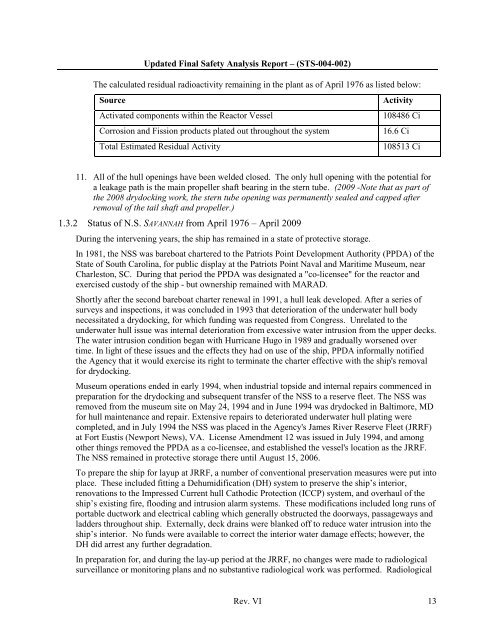10 CFR 50.71(e) - Maritime Administration - U.S. Department of ...
10 CFR 50.71(e) - Maritime Administration - U.S. Department of ...
10 CFR 50.71(e) - Maritime Administration - U.S. Department of ...
You also want an ePaper? Increase the reach of your titles
YUMPU automatically turns print PDFs into web optimized ePapers that Google loves.
Updated Final Safety Analysis Report – (STS-004-002)The calculated residual radioactivity remaining in the plant as <strong>of</strong> April 1976 as listed below:SourceActivityActivated components within the Reactor Vessel<strong>10</strong>8486 CiCorrosion and Fission products plated out throughout the system16.6 CiTotal Estimated Residual Activity<strong>10</strong>8513 Ci11. All <strong>of</strong> the hull openings have been welded closed. The only hull opening with the potential fora leakage path is the main propeller shaft bearing in the stern tube. (2009 -Note that as part <strong>of</strong>the 2008 drydocking work, the stern tube opening was permanently sealed and capped afterremoval <strong>of</strong> the tail shaft and propeller.)1.3.2 Status <strong>of</strong> N.S. SAVANNAH from April 1976 – April 2009During the intervening years, the ship has remained in a state <strong>of</strong> protective storage.In 1981, the NSS was bareboat chartered to the Patriots Point Development Authority (PPDA) <strong>of</strong> theState <strong>of</strong> South Carolina, for public display at the Patriots Point Naval and <strong>Maritime</strong> Museum, nearCharleston, SC. During that period the PPDA was designated a "co-licensee" for the reactor andexercised custody <strong>of</strong> the ship - but ownership remained with MARAD.Shortly after the second bareboat charter renewal in 1991, a hull leak developed. After a series <strong>of</strong>surveys and inspections, it was concluded in 1993 that deterioration <strong>of</strong> the underwater hull bodynecessitated a drydocking, for which funding was requested from Congress. Unrelated to theunderwater hull issue was internal deterioration from excessive water intrusion from the upper decks.The water intrusion condition began with Hurricane Hugo in 1989 and gradually worsened overtime. In light <strong>of</strong> these issues and the effects they had on use <strong>of</strong> the ship, PPDA informally notifiedthe Agency that it would exercise its right to terminate the charter effective with the ship's removalfor drydocking.Museum operations ended in early 1994, when industrial topside and internal repairs commenced inpreparation for the drydocking and subsequent transfer <strong>of</strong> the NSS to a reserve fleet. The NSS wasremoved from the museum site on May 24, 1994 and in June 1994 was drydocked in Baltimore, MDfor hull maintenance and repair. Extensive repairs to deteriorated underwater hull plating werecompleted, and in July 1994 the NSS was placed in the Agency's James River Reserve Fleet (JRRF)at Fort Eustis (Newport News), VA. License Amendment 12 was issued in July 1994, and amongother things removed the PPDA as a co-licensee, and established the vessel's location as the JRRF.The NSS remained in protective storage there until August 15, 2006.To prepare the ship for layup at JRRF, a number <strong>of</strong> conventional preservation measures were put intoplace. These included fitting a Dehumidification (DH) system to preserve the ship’s interior,renovations to the Impressed Current hull Cathodic Protection (ICCP) system, and overhaul <strong>of</strong> theship’s existing fire, flooding and intrusion alarm systems. These modifications included long runs <strong>of</strong>portable ductwork and electrical cabling which generally obstructed the doorways, passageways andladders throughout ship. Externally, deck drains were blanked <strong>of</strong>f to reduce water intrusion into theship’s interior. No funds were available to correct the interior water damage effects; however, theDH did arrest any further degradation.In preparation for, and during the lay-up period at the JRRF, no changes were made to radiologicalsurveillance or monitoring plans and no substantive radiological work was performed. RadiologicalRev. VI 13
















